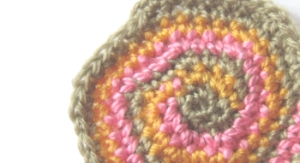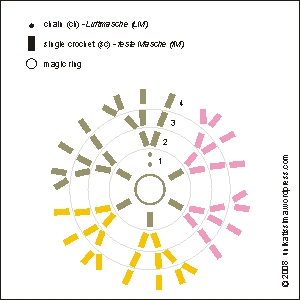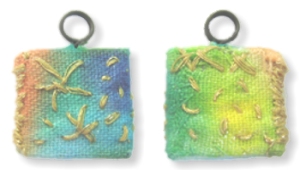
One day I wanted to have a pendant-to-be-embellished and decided to create it myself.
On the photo you see both sides of a charm of about 1,5 cm (appr. 0.6 inches) which I embellished with self-dyed fabric and some metallic yarn embroidery.
The embellishment isn’t quite what I dreamed of, but the core pendant worked well.
This is how I did it:
You need:
- some cardboard (the thickness of the middle piece must be about the same as the wire)
- some wire
- glue
 img 1: Cut 3 equal pieces of your cardboard.
img 1: Cut 3 equal pieces of your cardboard.
 img 2: Wrap the wire round a dowel to form the eye. Then turn a couple of times to form the peg and then form a bigger eye which will be hidden in the pendant.
img 2: Wrap the wire round a dowel to form the eye. Then turn a couple of times to form the peg and then form a bigger eye which will be hidden in the pendant.
Note: I prefer the hidden part of the wire to be an eye because then the wire can’t be dragged out by accident.
 img 3: Take the cardboard piece which will sit in the middle and trace your hanger.
img 3: Take the cardboard piece which will sit in the middle and trace your hanger.
 img 4: Cut out the place you will need for the hanger.
img 4: Cut out the place you will need for the hanger.
 img 5: Glue the hanger and the middle cardboard pieces onto one outer cardboard piece.
img 5: Glue the hanger and the middle cardboard pieces onto one outer cardboard piece.
Note: I glue on also the cardboard piece in the eye to prevent having a hollow.
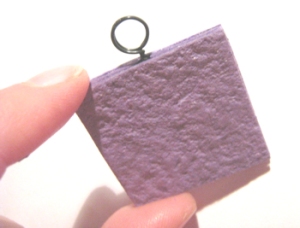 img 6: Glue the other outer cardboard piece onto. Your pendant-to-be-embellished is finished and you may begin with the embellishments.
img 6: Glue the other outer cardboard piece onto. Your pendant-to-be-embellished is finished and you may begin with the embellishments.


img 7 & 8: This is a solution for a 2-eyed pendant.
There are so many ways to embellish your self-made pendant (mini collages, painted, beaded, stamped etc), I’d love to see them.
Please feel free to comment here to show your trinkets.
Have fun!


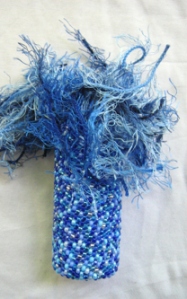

 The third photo shows the bottom of the blue bottle.
The third photo shows the bottom of the blue bottle.
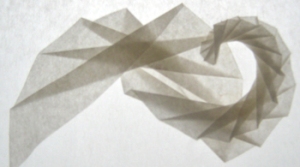

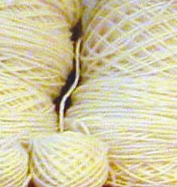


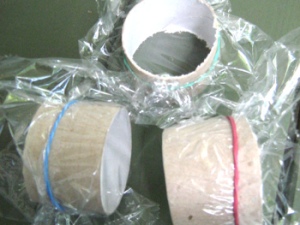
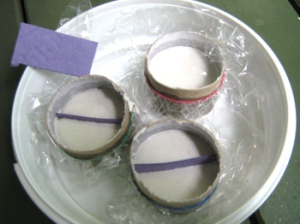



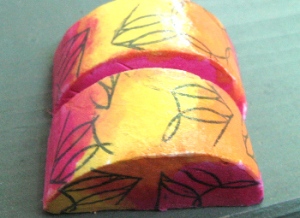

 img 1: Cut 3 equal pieces of your cardboard.
img 1: Cut 3 equal pieces of your cardboard. img 2: Wrap the wire round a dowel to form the eye. Then turn a couple of times to form the peg and then form a bigger eye which will be hidden in the pendant.
img 2: Wrap the wire round a dowel to form the eye. Then turn a couple of times to form the peg and then form a bigger eye which will be hidden in the pendant. img 3: Take the cardboard piece which will sit in the middle and trace your hanger.
img 3: Take the cardboard piece which will sit in the middle and trace your hanger. img 4: Cut out the place you will need for the hanger.
img 4: Cut out the place you will need for the hanger. img 5: Glue the hanger and the middle cardboard pieces onto one outer cardboard piece.
img 5: Glue the hanger and the middle cardboard pieces onto one outer cardboard piece. img 6: Glue the other outer cardboard piece onto. Your pendant-to-be-embellished is finished and you may begin with the embellishments.
img 6: Glue the other outer cardboard piece onto. Your pendant-to-be-embellished is finished and you may begin with the embellishments.

